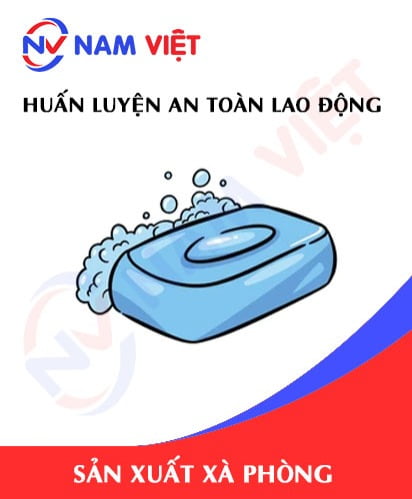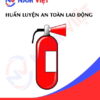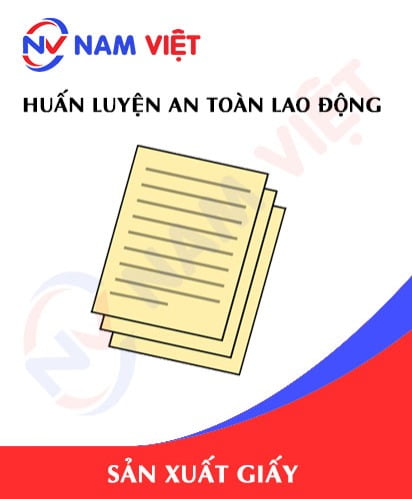Occupational Safety Training in Soap Manufacturing Factory
99,000 ₫
Note: The above price is calculated for one person and may fluctuate depending on the number of trainees participating in the course and market movements. For more accurate pricing support, please refer to the quotation table or contact our consulting staff directly.
Occupational safety is a critical issue in soap manufacturing factories and must be addressed promptly to ensure the health and safety of workers while enhancing the reputation of businesses. The Occupational Safety Training course is one of the effective solutions to raise awareness among workers on preventing occupational accidents during soap manufacturing.
Table of Contents
Toggle1. Overview of soap
a. What is soap?
- Soap is a material widely used in daily life for cleaning and washing. It is produced from a chemical process called saponification, in which a fat (usually vegetable or animal oil) reacts with an alkaline solution (usually potassium hydroxide or sodium hydroxide) to form soap and glycerin.
- Soaps are manufactured with various formulas and ingredients depending on the purpose of use and market demand. Soap can be white, light yellow, scented, unscented, solid or liquid, suitable for washing, cleaning, and caring for the body, hair, clothes, household items, and many other surfaces.
- Soap is a natural material and is biodegradable, so it is considered an environmentally friendly solution to replace chemical detergents containing toxic compounds.
- According to the General Statistics Office, Vietnam’s soap output in 2021 reached about 530 thousand tons, an estimated growth of about 10% compared to the same period last year. In which, hand soap production accounted for a large proportion and grew significantly, especially in the context of the complex development of the COVID-19 pandemic and people increasing their personal hygiene.
- In addition, soap manufacturing enterprises in Vietnam tend to invest in modern manufacturing technology, improve product quality and manufacturing processes, and develop diverse and environmentally friendly soap products to enhance competitiveness in the domestic and international markets.

b. Types of soap manufacturing machines
Common types of soap manufacturing machines today include:
- Mixer: The mixer is used to mix the main ingredients of soap such as vegetable oil, soda, water, salt, and colorants, fragrances, fruits… This is the first important step in the soap manufacturing process.
- Milling machine: The milling machine is used to flatten and compress the soap bars after they are mixed. Passing the soap through the milling machine helps increase the thickness and firmness of the soap.
- Pressing machine: The pressing machine is used to press the soap bars into the desired shape and size. In addition, the pressing machine also helps create soap products with special shapes such as hearts, flowers…
- Packaging machine: The packaging machine is used to package the soap bars for sale. The packaging machine can also design and print directly on the product packaging to create an attraction for consumers.
In addition, many other devices and tools are used in the soap manufacturing process such as: scales, mixing tanks, grinders, mills, heat presses…

c. Typical soap manufacturing enterprises
In Vietnam, there are many soap manufacturing enterprises, of which some typical ones include:
- Unilever Vietnam: is a multinational company operating in the field of manufacturing and distributing consumer products, including soap manufacturing. This company has been present in Vietnam since 1995 and manufactures many types of soap such as Lifebuoy, Lux, Omo, Sunlight…
- P/S Vietnam: is a famous brand in the field of manufacturing and distributing oral care products and soap. P/S has been present in Vietnam since 1996 and manufactures many types of soap such as P/S, Clear…
- Vinamilk Yogurt Co., Ltd.: is one of the leading companies in the field of milk production in Vietnam, but the company also manufactures and trades in some other products such as soap, toothpaste, hand sanitizer…
- Kao Vietnam Co., Ltd.: is a company of Japanese origin, operating in the field of manufacturing and distributing health care and personal hygiene products, including soap. Kao Vietnam’s soap products include Merries, Attack, Biore…
In addition, there are many other soap manufacturing enterprises such as Duy Tan, Lix, Laundrin, Comfort, Surf Excel…
d. Specific jobs in a soap factory
Group 1
- Executive director, deputy executive director, department head in a soap factory.
Group 2
- Safety officer: manages safety in the factory, designs safety procedures, supervises and urges employees to comply with safe working procedures.
Group 3
- Soap manufacturing process: Includes the steps of mixing, melting, pelletizing, and packaging soap products.
- Quality control: Engineers and specialized staff are trained to check the quality of ingredients, supervise manufacturing processes, and check the quality of soap products to ensure product quality and user safety.
- Factory hygiene: Workers must comply with factory hygiene procedures, protect food hygiene, and prevent the invasion of harmful bacteria and insects.
- Maintenance and repair: Technicians are trained to maintain and repair machinery, systems, equipment, mechanics, and electricity in a soap factory.
- Packaging and shipping: Workers must prepare, package, and ship soap products to retailers or customers.
- Manufacturing management and manufacturing planning: Managers must manage soap manufacturing, plan production, monitor the manufacturing process, control product quality, and ensure the effective and profitable operation of the factory.
Group 4
- Office jobs, services, sales, marketing.
- Manufacturing management, quality management, human resource management, material management, financial and accounting management.
- Research and development of new products, design of product packaging.

2. Overview of the occupational safety training course for soap manufacturing
Within the scope of this article, we focus on issues related to Group 3, because Group 3 is the group directly involved in the manufacturing process, bearing the highest risk of workplace accidents. Refer to other groups here
a. What is Group 3 occupational safety training?
- Occupational safety training for Group 3 are training sessions that equip workers with awareness of how to prevent workplace accidents.
- The occupational safety training course will help workers recognize and prevent dangers, and limit the risk of workplace accidents while working.
REGISTER FOR OCCUPATIONAL SAFETY TRAINING SERVICES
b. Training time
Initial safety training time
- The total training time is at least 24 hours, including the exam time.
- 8 hours of theoretical study on the policy and legal system on occupational safety and health
- 8 hours of theoretical study on basic knowledge of occupational safety and health
- 4 hours of theoretical study on specialized training content
- 2 hours of practical study on specialized training content
- 2 hours of theoretical examination at the end of the training course
The safety training center will allocate the time into many training sessions depending on the arrangement of study time for employees. But normally, there will be 6 training sessions, the course will last 3 days, on the condition that the manufacturing enterprise can arrange continuous study time.
Periodic safety training time
- Before the occupational safety card expires, if workers want to get a new one, they must undergo a periodic occupational safety training course, with the periodic safety training time being at least 50% of the initial safety training time.
Explanation: The total periodic occupational safety training time is at least 12 hours, including the exam time. After completing the periodic training course and passing the exam, workers will be re-issued or have their occupational safety card renewed.
c. Content of the training course
| No. | TRAINING CONTENT | TRAINING TIME (HOURS) | |||
| Total | Of which | ||||
| Theory | Practice | Exam | |||
| I | Policy and legal system on occupational safety and health | 8 | 8 | 0 | 0 |
| 1 | Overview of the system of legal documents on occupational safety and health. | 6 | 6 | ||
| 2 | System of technical standards and regulations on occupational safety and health. | 1 | 1 | ||
| 3 | Specific regulations of state management agencies on occupational safety and health when building new, expanding, or renovating works, facilities for manufacturing, using, preserving, storing, and inspecting machines, equipment, materials, and substances with strict requirements on occupational safety and health. | 1 | 1 | ||
| II | Basic knowledge of occupational safety and health | 8 | 8 | 0 | 0 |
| 1 | Basic knowledge of dangerous and harmful factors in the workplace. | 4 | 4 | ||
| 2 | Methods for improving working conditions. | 1 | 1 | ||
| 3 | Safety culture in manufacturing and business. | 1 | 1 | ||
| 4 | Rights and obligations of employers and employees; policies and regimes on occupational safety and health for employees; functions and duties of the safety and health network. | 1 | 1 | ||
| 5 | Occupational safety and health regulations, signs, occupational safety and health instructions, and use of safety equipment, personal protective equipment; professional skills, first aid for workplace accidents, prevention of occupational diseases. | 1 | 1 | ||
| III | Specialized training content | 6 | 4 | 2 | 0 |
| General knowledge of types of machines, equipment, substances that generate dangerous and harmful factors; analysis, assessment, risk management of occupational safety and health, safe working procedures with machines, equipment, substances with strict requirements on occupational safety and health. | 6 | 4 | 2 | ||
| IV | Occupational safety training exam at the end of the course | 2 | 2 | 0 | 0 |
| Total | 24 | 22 | 2 | ||
See more training content of 6 groups
d. Occupational safety card
After completing the occupational safety training course and at the same time passing the exam, the worker will be issued an occupational safety card (in practice, also called the occupational safety certificate for Group 3).
In which, the Group 3 safety card will clearly show information such as: full name, date of birth, specific job and working environment. At the same time, it also has the training time, red stamp, and signature confirming the completion of the training course.
According to the regulations on issuing safety cards specified in Clause 2 Article 24 of Decree 44/2016/ND-CP, it is divided into 2 cases:
- In the case that the employer and the employee have an employment contract, the employer must sign, stamp, and seal the safety card for the trained person belonging to Group 3 after undergoing the training course from the occupational safety training unit and passing the exam.
- In the case that the worker is freelance, seasonal, and does not have an employment contract, the training unit must sign, stamp, and seal the safety card for the worker after undergoing the training course from the occupational safety training unit and passing the exam.

3. Recognizing hazards when manufacturing soap
During the soap manufacturing process, there are some potential hazards as follows:
- Soap is a flammable substance, so there is a risk of fire and explosion during manufacturing, especially when handling chemicals such as alkali.
- In the soap manufacturing process, high temperatures must be used, so there is a risk of burns when in contact with hot machines or hot solutions.
- During manufacturing, chemicals such as alkali, acid, and caustic soda are used to create soap, and they can be dangerous if not used correctly or if they come into contact with skin and eyes.
- If waste from the soap manufacturing process is not handled properly, it can cause environmental pollution and harm human health.
- Electrical equipment in the factory is not regularly maintained, not properly insulated, and not waterproof, which can cause the risk of electric shock to workers during manufacturing.
- Workers can be struck by fast-moving machine parts, such as shafts, fan blades, gears, or other parts when operating. Moving machine parts, such as conveyor belts, gears, or shafts, can entangle and crush workers when they get too close.
4. Common workplace accidents when manufacturing soap
Common workplace accidents during the soap manufacturing process include:
- Burns: Due to the high temperature of solutions and machines during manufacturing.
- Chemical poisoning: Due to contact with chemicals such as alkali, acid, caustic soda, and other toxic compounds.
- Clogged pipeline systems: Due to dirt or foreign objects depositing in pipes and machines.
- Eye injuries: Due to contact with chemicals or unexpected objects.
- Falls, bumps: Due to transportation and movement activities in the factory.
- Entrapment accidents: due to carelessness during machine operation where the worker gets caught in moving mechanisms.
- Electric shock accidents: soap manufacturing machines leaking electricity or workers operating them incorrectly leading to electric shock.
5. Safety measures when participating in soap manufacturing
Safety measures when participating in soap manufacturing include:
- To avoid direct contact with chemicals during manufacturing, workers should wear personal protective equipment such as face masks, gloves, safety glasses, and chemical-resistant aprons.
- The soap factory must maintain cleanliness, creating a safe working environment for workers.
- Workers need to be trained in occupational safety about potential hazards during manufacturing, how to use protective equipment, and how to handle situations in case of an incident.
- Equipment and machines in the soap factory need to be regularly checked and maintained to ensure the safety of workers.
- Chemicals in the soap manufacturing process need to be properly classified, packaged, and stored to avoid incidents.
- The soap factory needs to ensure good ventilation to minimize the accumulation of toxic fumes and prevent the risk of fire and explosion.
- Soap factories must fully comply with state safety regulations, including regulations on environmental protection, occupational hygiene, and product quality.
- Periodically organize workplace environment monitoring in factories and manufacturing plants, collect and analyze harmful factors to workers, thereby adjusting to reduce the level of harm to prevent occupational diseases for them.

6. Benefits of occupational safety training in soap manufacturing
An Toan Nam Viet provides your enterprise with excellent benefits after completing occupational safety training courses as regulated in Decree 44/2016/ND – CP on occupational safety and health work, Companies, manufacturing plants, enterprises.
- Employees can identify potential risks of workplace accidents and thus have preventive measures to avoid workplace accidents.
- Your enterprise can establish risk prevention measures in the manufacturing, operation, and maintenance processes.
- Minimize costs when occupational safety risks occur.
- Uninterrupted manufacturing will help increase labor productivity and product quality.
- Comply with occupational safety laws, avoiding legal risks.
- Build a professional reputation in all aspects, thereby enhancing your brand.
Nam Viet’s training courses are a solution to prevent and combat external factors from affecting each individual so that they can avoid danger that can lead to injury or, more seriously, death.
REGISTER FOR OCCUPATIONAL SAFETY TRAINING SERVICES
7. Customer feedback after completing occupational safety training in soap manufacturing
An Toan Nam Viet has many years of experience in the mission of accompanying many enterprises in Vietnam in general and in the southern provinces in particular. And that responsibility is something extremely precious to Nam Viet, which is why Nam Viet’s Occupational Safety Training work is increasingly focused on becoming professional. And the motivation for An Toan Nam Viet to grow strongly to this day comes from the positive feedback and suggestions from enterprises. Below are the feedbacks from our partners we have served.
Bac Nam E&C Investment and Construction Joint Stock Company
“The first time I used An Toan Nam Viet’s service, I was very surprised by the enthusiastic 24/7 support of the consulting team. The class organization was very quick and convenient for our company, thank you very much for Nam Viet’s service!”
Hoa Dat Construction and Trading Joint Stock Company
“Nam Viet’s service has helped us a lot in simplifying occupational safety and completing safety records for our work process. The consulting team is enthusiastic and timely in answering our questions. 5 stars for Nam Viet”
See more customer interviews after using An Toan Nam Viet’s service
8. Occupational Safety Training Competence of An Toan Nam Viet
An Toan Nam Viet is a reputable and quality occupational safety training center in Vietnam today. With occupational safety training sessions taking place continuously at manufacturing workshops, factories, or construction sites across the country (63 provinces and cities in Vietnam).
REGISTER FOR OCCUPATIONAL SAFETY TRAINING SERVICES
Occupational safety training license
- An Toan Nam Viet has been inspected by the Department of Occupational Safety of the Ministry of Labor – Invalids and Social Affairs and granted a certificate of eligibility to operate occupational safety and health training. This further strengthens our ability to conduct occupational safety training.

Documents and lectures
- Before occupational safety training documents are included in the occupational safety training courses, they are reviewed and censored to ensure that the lectures are always correct in terms of knowledge and effective when applied.
- The teaching method of the lecturers is synchronized according to the teaching standards of An Toan Nam Viet, which is a method that experts in occupational safety and health training have researched and summarized during the teaching process to bring the highest knowledge acquisition efficiency to students.
Facilities
- Controlling the factors in the classroom that affect the training process will increase teaching performance and the effectiveness of knowledge acquisition for students.
- Our facilities to support the training course always arrange spacious classrooms that meet standards for area, lighting, training equipment, etc.
9. Reputable and quality safety training center nationwide
At An Toan Nam Viet, we always put the professional dedication to occupational safety training as our top priority. For us, imparting the knowledge of self-protection to workers so that they can have a safe foundation on their career path is a contribution to building the country.
To ensure effective training, we prepare carefully and meticulously every little detail. From preparing tools, equipment, teaching devices to textbooks, documents, sound, and lighting.
Our occupational safety training lecturers are experts with many years of experience in the field. They even have research projects to identify hazards in all occupations and how to prevent them.
The lecturer’s lectures are summarized from reality and conveyed in the most vivid and easy-to-understand way to the workers. These factors help workers feel comfortable during their study time and absorb our teaching knowledge well. Of course, the knowledge conveyed always closely follows Decree 44/2016/ND-CP.
From there, they grasp many measures to prevent dangers and how to protect themselves. At the same time, they also apply it in the most suitable way in their actual work.
Our safety training center is proud to be a unit that provides reputable and professional occupational safety training services with the following advantages:
- Competitive training costs but training quality is still guaranteed.
- Flexible training schedule with the production situation of the Company or enterprise.
- Quick and legal procedures for issuing occupational safety training certificates.
- Training lecturers are people with many years of experience in the profession.
- The classroom is controlled for factors that affect the training process to increase teaching performance and the effectiveness of knowledge acquisition for students.
- The lectures are compiled to be suitable for occupational safety work at enterprises.
- An Toan Nam Viet works dedicatedly and professionally to support customers accurately and as quickly as possible.

10. Refer to more occupational safety training documents for soap manufacturing
- Occupational safety documents for soap manufacturing
- Set of occupational safety training documents
- Set of occupational safety training exam questions
- Multiple-choice exam for occupational safety in soap manufacturing
- Slides of the lecture on occupational safety training for soap manufacturing
1 review for Occupational Safety Training in Soap Manufacturing Factory
No comments yet















namchinh.haiphong341
Dịch vụ tốt nhé! triển khai nhanh chóng và chu toàn